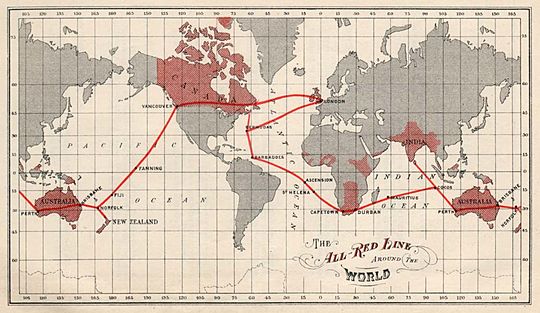All Red Line facts for kids
The All Red Line was a huge system of electrical telegraph cables. These cables connected many parts of the British Empire around the world. It officially started working on October 31, 1902. The name "All Red Line" came from how the British Empire's lands were often colored red or pink on world maps. This network helped people send messages quickly across vast distances.
Contents
Building the Global Cable Network
The idea of connecting continents with cables started early. The very first transatlantic cable linked Ireland and Newfoundland in 1858. However, it did not work for long. In 1866, a ship called the SS Great Eastern laid a stronger cable. This cable created a lasting connection from Waterville, County Kerry and Valentia Island in Ireland to Heart's Content, Newfoundland.
Connecting to Asia and Australia
By 1870, the city of Suez was connected to Bombay (now Mumbai) in India. From there, cables reached Madras (now Chennai), Penang, and Singapore. Australia got its direct link to British telegraph cables in 1871. This was done by extending a line from Singapore to Port Darwin. Even though it passed through Dutch territory, it connected Australia. By 1872, messages could travel directly from London to Adelaide and Sydney. Australia was then linked to New Zealand by cable in 1876.
Completing the Pacific Link
To finish the All Red Line, the biggest project was laying the cable across the Pacific Ocean. Leaders from the British Empire discussed this at meetings called "Colonial Conferences." They agreed to the plan in 1894.
A group called the "Pacific Cable Committee" was formed in 1896. In 1901, the Pacific Cable Board was created to manage the project. It had members from Britain, Canada, Australia, and New Zealand. These governments also helped pay for the project. In 1902, a new ship named Colonia started laying the huge cable. This cable weighed 8,000 tonnes and connected Bamfield, British Columbia, in Canada to Fanning Island. The whole project cost about £2 million.
Why Fanning Island Was Important
The British government wanted the All Red Line to only touch land controlled by Britain. This was for security reasons. Because of this, Britain worked hard to get Fanning Island (now called Tabuaeran in Kiribati). This island was needed as a midpoint station. It would help boost the signal for the long cable across the Pacific Ocean. Britain officially took control of Fanning Island in 1888.
The Network's Strength and Importance
In 1911, a report said the All Red Line was fully complete. The network had many backup lines. This meant it was very hard to break. For example, it would take 49 cuts to stop messages from reaching the United Kingdom. It would take 15 cuts for Canada and 5 for South Africa. Many colonies like South Africa and India also had many land lines. Britain also had most of the world's special equipment and skills to lay and fix underwater cables. They also had a special material called gutta-percha for insulating the cables.
The 1911 report also said that radio messages (from the Imperial Wireless Chain) should only be a backup. This was because enemies could easily stop or listen to radio messages. Even though it cost a lot, the telegraph network worked very well. British communications stayed strong during the First World War. At the same time, Britain quickly managed to cut off Germany's own worldwide communication network.
Between 1923 and 1926, the Pacific Cable Board laid another cable. This duplicate cable ran between Canada and New Zealand. They used ships called Dominia and Faraday for this task.
Key Cable Stations
Here are some of the main places where the All Red Line cables connected:
Atlantic Ocean Stations
Pacific Ocean Stations
- Bamfield, British Columbia, Canada
- Fanning Island (which was empty until the telegraph station was built)
- Fiji
- Hong Kong
- Norfolk Island (with branches to New Zealand and Australia)
- Southport, Queensland, Australia (the old Pacific Cable Station building is still there)
Indian Ocean Stations
- Cape Town, South Africa
- Durban, South Africa
- Keeling Islands (with branches to India and Africa)
- Mauritius
- Perth, Australia
Commonwealth Telegraph Agreement
As the British Empire changed and many countries became independent, a new agreement was needed. This agreement would make it clearer how to share costs and manage the telegraph network. In 1948, a treaty called the Commonwealth Telegraph Agreement was signed in London. This agreement formed the Commonwealth Telecommunications Organisation.
See also
- All-Red Route
- Commonwealth Pacific Cable System
- Electrical telegraphy in the United Kingdom


